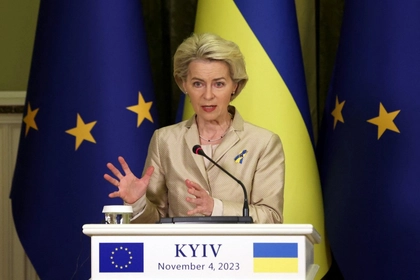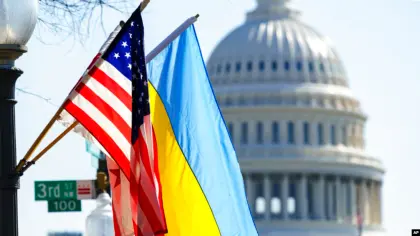Continued Western support is crucial if Ukraine is to succeed. Although the United States has been unequivocal about the fact that it supports Ukraine, it keeps sending mixed messages about what victory looks like.
Ukraine has displayed incredible prowess, both in military and informational terms. Nevertheless, without the support of the United States and other Western partners, it is safe to say that the Ukrainian army and government would have been overrun shortly after Russia launched its full-scale attack. In all probability, without the help of a NATO, Ukraine would be now forced to fight a guerilla war. Instead, Ukraine has proven itself capable of launching combined arms counterattacks.
Initially, the stars of the war were hand-held anti-tank weapons – U.S. Javelins, British NLAWs – and their anti-aircraft equivalents, Stingers and Starstreaks. The Ukrainians used them deftly, pushing the Russians away from Kyiv. Even the top-brass in the U.S. was surprised.
Then came the grinding artillery war in the Donbas. Almost too late, the U.S. and its allies finally started supplying Ukraine with high-precision artillery. The HIMARS rocket launching system became a game changer and allowed Kyiv to close the gap on Russia’s artillery advantage.
Believing in Ukraine’s victory
To most observers, Ukraine appears to have turned the tide. They now look like they can win. And “win” in this case means not merely returning to the pre-Feb. 24 line of control, but to the borders as they existed from before Russia’s invasion of Crimea in 2014. Military analysts, like former U.S. generals Mark Hertling and Wesley Clark, have been insisting from the outset that Ukraine can win – as long as they receive enough of the right weapons in a timely fashion.

EU Transfers €1.5 Bln Raised From Russian Assets for Ukraine
Nevertheless, when in April, during a trip to Europe, Antony Blinken, the U.S. secretary of state, and Lloyd Austin, the secretary of defense, explicitly said that they supported Ukraine’s victory, or at least the defeat of Russia, they caught some flak from U.S. President Joe Biden on their way home. NBC news reported in June that Biden had asked them to tone down their rhetoric.
At that point in the fighting, Ukraine looked like it might get bogged down in a protracted war of attrition. Pessimists in the U.S. government and media were calling on President Volodymyr Zelensky to be more “realistic” and consider some sort of compromise.
Then came the successful Kharkiv offensive in September, and now Russia’s withdrawal from Kherson. At this stage, worriers have latched onto the looming specter of nuclear catastrophe to perhaps pressure Zelensky into a ceasefire or negotiations. Those with a better understanding of military matters, however, recognize more clearly than ever that Ukraine’s fight is eminently winnable.
Without poking the wounded animal
Thus far, U.S. strategy in Ukraine has required an ongoing balancing act. The U.S. is trying to support Kyiv militarily without seeming to want Russia’s defeat. It’s more than a dilemma; it’s an outright contradiction. And many Russian hierarchs know it.
But appearances can mitigate a lot. Hence, the U.S. attention to optics.
On the one hand, Washington cannot allow Moscow to extract any sort of reward from its attack on Ukraine. On the other hand, it does not want to appear to be backing Russian President Vladimir Putin into a corner where he might do something desperate, like using a nuclear weapon. Nor does Washington want to alienate its European allies, already chafing under the weight of higher energy prices and the attendant inflation.
In other words, the dilemma is pushing Washington to pursue the proverbial “boiling frog syndrome.” If a frog is placed in a boiling pot of water, it will jump out to save its life. But if a frog is placed in a pot of water that boils slowly enough, it won’t notice it’s being cooked until it’s too late.
American policy with regard to arms deliveries seems to be following this slow-boil approach. While Washington continues to supply crucial weapons systems, it has thus far balked on sending planes, tanks or long-range missiles that might make the obvious too evident: i.e., that Russia is arrayed not only against NATO-trained Ukrainian soldiers, but also against NATO weapons as well.
The key to America’s tightrope walk is optics. Washington must appear to be helping only as much as is absolutely necessary to ensure Ukraine’s defense. Anything that smacks of offensive capabilities – planes, Abrams tanks, ATACMS long-range missiles – is considered too provocative.
In recent weeks, this aspect of U.S. strategy has manifested with Washington pressuring Zelensky to do a U-turn on his vow not to negotiate with Russia as long as Putin is in power. It has also led to leaks coming from some NATO-country officials: for example, Italian daily La Repubblica reported on Nov. 7 that some unnamed NATO officials claimed negotiations would begin in earnest once the Russians withdrew from Kherson.
Indeed, Gen. Mark Milley, U.S. Chairman of the Joint Chiefs of Staff, told CNBC News on Nov. 10 that a winter lull in fighting would provide an “opportunity” for negotiations. The British Daily Mail even reported on Nov. 11 that a Kremlin insider was privy to the “terms of surrender” Kyiv has offered Moscow in recent days.
America plays good cop to a bellicose Zelensky
Zelensky has proven himself to be a master of optics and messaging. As a performer he developed a seemingly innate sense of timing when communicating. Over the course of the war he has seduced much of the world with a mix of tenacity and earnestness, through which that lighthearted bonhomie he projected before his entry into politics seeps through in measured doses.
Although it may not be intentional, a dynamic is developing in which the Americans will try to appear as if they are holding the Ukrainians on a leash. If that is to be credible, then Washington must make the Russians feel as if Ukraine’s tenacity and Russia’s own blunders are the direct cause of their defeat, rather than the superiority of NATO’s weapons and intelligence.
And yet, many hawks in both the U.S. and Ukraine challenge such tactics, arguing that too much focus on optics only deviates energy from the priority. They contend that it doesn’t matter what Washington does, or appears to do. Moscow will in any event need to spin the image of some sort of victory out of what is looking increasingly like a fiasco. “Of course, we lost,” they might say, “But we stood up to NATO and most of the world, and still managed to hold our own.”
In the meantime, the Armed Forces of Ukraine – thanks to NATO’s high-tech largesse – is steadily evicting Russia from its territory.
You can also highlight the text and press Ctrl + Enter






